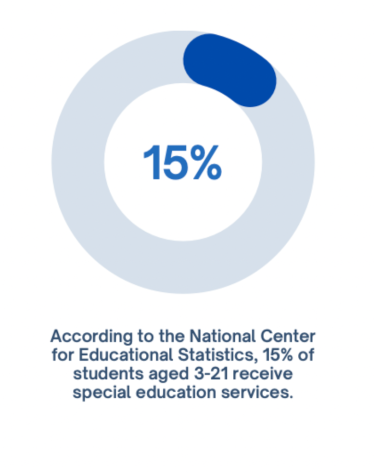Looking at accessibility within Cherry Hill schools: Learning Accessibility
November 28, 2022
“Special education [is] like putting a square peg in a small round hole,” said Cherry Hill Special Education PTA (CHSEPTA) President Jennifer Naddeo. In other words, there is simply no “one
size fits all” approach when it comes to students’ learning. With students of all different interests and abilities in our classrooms, it is not practical to assume that they will all thrive under the same
teaching and evaluation methods.
Currently, Cherry Hill offers Individualized Education Program (IEP) and 504 plans for students with learning disabilities.
Perry explained that for students who have a 504 plan, accommodations for learning needs can include extra time on tests, reduced homework loads, notes from teachers and more. 504 plans also extend to physical accommodations, such as elevator access or audio systems to aid students who are hard of hearing.

At East, each grade level has a committee, headed by the grade level’s assistant principal, whose purpose is to review and evaluate requests for 504 plans for students in that grade. To apply for a 504 plan, a student must first submit evidence of a medical diagnosis and demonstrate a need for accommodations. From there, the student’s parents, guidance counselor, grade level assistant principal and teachers meet to design the ideal accommodations plan for the student.
Compared to a 504 plan, an Individualized Education Program (IEP) provides more extensive accommodations by creating a unique, modified learning plan for each student.
Different levels of IEP plans can include having a special education teacher make modifications to students’ learning, having an inclusion teacher in the classroom and using a different educational program as a whole. For students who are looking to get an IEP, they first go through an evaluation meeting that can be based on if a teacher or parent sees that they are struggling in different areas. The evaluation can be based on many different topics including speech, occupational therapy and functional behavior, and is used to see what is being affected and how to help. After the evaluation meeting, an eligibility meeting occurs, following strict guidelines of testing, to see if a student is eligible for special education services. Once the family receives the results, a team of people including a case manager, general education teacher, special education teacher, family and more people depending on the circumstances (including the student “whenever appropriate” according to the Individuals with Disabilities in Education Act), reads the evaluation and decides whether the IEP should be granted. The team will meet yearly to reevaluate the accommodations offered to the student if an IEP is granted.
The CHSEPTA’s mission statement is “to offer support, education, socialization and advocacy for children with special learning needs, their families and educators.” CHSEPTA helps students and families by providing information about services and programs throughout our district.
Naddeo still shows that change needs to be made to make Cherry Hill an accessible place for all students.
“I get calls [from families] where everything worked out fine, and they love their program, they love their teacher, they think that their students are doing fantastic in Cherry Hill School District… And then, we get the phone calls where it’s almost like communication is shut down and it doesn’t feel like their student has been welcomed or accepted and they’re not able to get what they need.”
Naddeo is advocating for changes to be implemented into the education system, one of which is providing more in-class resources, especially for Advanced Placement (AP) and honors-level classes as well as required classes such as Financial Literacy.
With an in-class resource program, a class is led by two teachers — one subject teacher and one special education teacher (the in-class resource teacher). The in-class resource teacher provides specialized instruction for students with learning disabilities. In this way, students can take highly rigorous classes while also making sure their educational needs will be met. In-class resources are especially needed in honors and AP level classes, said Naddeo, because of the emphasis placed on taking high level courses in today’s college admissions.
Currently, it is unlawful to deny a student with a disability admission to an accelerated class or program solely because of that student’s need for special education or related aids and services, or because that student has an IEP or 504 plan. While our school district does allow students with disabilities access to advanced classes, it doesn’t provide the necessary support for students due to a lack of in-class resources.
There still remains a stigma associated with learning accommodations and the misconception that students with such plans are given an “unfair advantage.” “
I wear glasses as an accommodation for my eyesight, and if I don’t wear my glasses, it makes it challenging for me to read things [or] to see things and it might take longer to focus and I might not understand something as well… For students that may not have any kind of reading challenges, dyslexia,
things like that, you may not understand the needs [of] someone who does,” said Perry.
Regarding the accommodations that could be executed, there are many ways schools can make facilities more accessible for people with disabilities. For example, schools could implement a system for recording the lessons for those who may need extra time to grasp the information provided. Lastly, teachers should also keep in mind the distractions that may impact some disabled students’ ability to learn. This includes students walking around in the hallways and having other students in too-close settings such as when using tables that are not large enough.
Learning, equity, and acceptance: accessibility can affect all three drastically, impacting the environment that a student relates to their education.
“When our children go into a school, what I hope is that they’re accepted by their classmates, because that makes a big difference in someone’s learning,” said Naddeo.